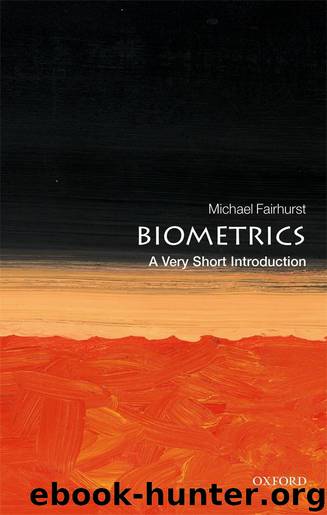Biometrics by Michael Fairhurst

Author:Michael Fairhurst
Language: eng
Format: epub
ISBN: 9780192536792
Publisher: OUP Oxford
Published: 2018-09-20T16:00:00+00:00
Facial images in biometric recognition
It is not surprising that using images of the face to recognize individuals has attracted much attention over many years, since this is perhaps the principal way in which we, as human beings, generally recognize others (the sound of the human voice is comparably effective in the human repertoire of recognition feats, but even this probably cannot compete with using the visual appearance of the face). We usually give this little thought, accustomed as we are to operating within an environment where the visual sense is so important, yet if we do stop and consider this activity, we will see how remarkable a facility is our capacity to recognize, and distinguish between, different faces.
It is so remarkable largely because each human face is, at a high level at least, very similar, and what distinguishes one face from another essentially comes down to rather small variations in specific landmarks. Moreover, we seem to be pretty good at this task even when part of the face is occluded, because of a hairstyle or the wearing of a hat/head-covering, for example, or when—as happens all the time—the facial expression changes to reflect mood or current circumstances, or when we see the face from an angle which changes its detailed appearance. We can usually distinguish between family members, even when striking family likenesses have been passed along the generations. Other factors can also play a part in changing facial appearance, but maybe even more subtly. For example, some of us wear glasses (but not necessarily all the time), but maybe we change their style from time to time. Make-up is often applied to the facial area or, after a holiday, a suntan may change the colour and texture of the skin, and we can think of many other influences on the appearance of the face, yet most of us seem able to cope with such a range of natural variability, usually—forgiving the pun—without batting an eyelid. This familiarity with facial recognition, and the ease with which we are able to carry it out, has meant that even before biometrics became the pervasive technology we currently know, computer scientists, engineers, forensic scientists, and others have worked to develop powerful algorithms capable of extracting useful information from facial images.
In fact, although here we are mainly concerned with the face as a means of identifying its ‘owner’, the face can reveal information about a surprising range of characteristics, including for example the age of the subject; whether the subject is male or female; the subject’s mood (happy, sad, etc.); the subject’s current state of mind (depressed, anxious, etc.); the degree of engagement of the subject with the viewer; the level of familiarity of the viewer to the subject, and so on. And, perhaps surprisingly, all these properties can be discerned on the basis of often very small changes in appearance. Little wonder, then, that the face has a unique place in our understanding of human behaviour, human psychology, and human communication, let alone as a basis for identifying individuals.
Download
This site does not store any files on its server. We only index and link to content provided by other sites. Please contact the content providers to delete copyright contents if any and email us, we'll remove relevant links or contents immediately.
Learning SQL by Alan Beaulieu(6152)
Weapons of Math Destruction by Cathy O'Neil(6075)
Digital Minimalism by Cal Newport;(5576)
iGen by Jean M. Twenge(5294)
Sapiens by Yuval Noah Harari(5255)
The Age of Surveillance Capitalism by Shoshana Zuboff(4108)
Elon Musk by Ashlee Vance(3976)
Thing Explainer by Randall Munroe(3842)
Apollo 8 by Jeffrey Kluger(3592)
Future Crimes by Marc Goodman(3451)
The Science Book (Big Ideas Simply Explained) by DK(3174)
Who Can You Trust? by Rachel Botsman(3055)
I Live in the Future & Here's How It Works by Nick Bilton(2896)
Infinite Energy Technologies by Finley Eversole(2887)
Steve Jobs by Walter Isaacson(2794)
Dawn of the New Everything by Jaron Lanier(2706)
The Innovators: How a Group of Hackers, Geniuses, and Geeks Created the Digital Revolution by Walter Isaacson(2659)
Chernobyl by Serhii Plokhy(2464)
Ben Franklin's Almanac by Candace Fleming(2418)
